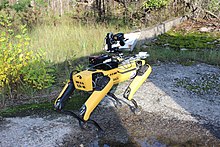Cadmium zinc telluride
Cadmium zinc telluride, (CdZnTe) or CZT, is a compound of cadmium, zinc and tellurium or, more strictly speaking, an alloy of cadmium telluride and zinc telluride. A direct bandgap semiconductor, it is used in a variety of applications, including semiconductor radiation detectors, photorefractive gratings, electro-optic modulators, solar cells, and terahertz generation and detection. The band gap varies from approximately 1.4 to 2.2 eV, depending on composition.[1]
Characteristics


Radiation detectors using CZT can operate in direct-conversion (or photoconductive) mode at room temperature, unlike some other materials (particularly germanium) which require cooling. Their relative advantages include high sensitivity for X-rays and gamma rays, due to the high atomic numbers of Cd and Te, and better energy resolution than scintillator detectors.[2] CZT can be formed into different shapes for different radiation-detecting applications, and a variety of electrode geometries, such as coplanar grids [3] and small pixel detectors,[4] have been developed to provide unipolar (electron-only) operation, thereby improving energy resolution. A 1 cm3 CZT crystal has a sensitivity range of 30 keV to 3 MeV with a 2.5% FWHM energy resolution at 662 keV.[5] Pixelated CZT with a volume of 6 cm3 can achieve 0.71% FWHM energy resolution at 662 keV and perform Compton imaging.[6]
See also
References
- ^ Capper, Peter (1994). Properties of Narrow Gap Cadmium-based Compounds. INSPEC. p. 618. ISBN 0-85296-880-9.
- ^ Wilson, Matthew David; Cernik, Robert; Chen, Henry; Hansson, Conny; Iniewski, Kris; Jones, Lawrence L.; Seller, Paul; Veale, Matthew C. (2011). "Small pixel CZT detector for hard X-ray spectroscopy". Nuclear Instruments and Methods in Physics Research Section A: Accelerators, Spectrometers, Detectors and Associated Equipment. 652 (1): 158–161. Bibcode:2011NIMPA.652..158W. doi:10.1016/j.nima.2011.01.144.
- ^ Luke, P.N. (1995). "Unipolar charge sensing with coplanar electrodes -- application to semiconductor detectors". IEEE Transactions on Nuclear Science. 42 (4): 207–213. Bibcode:1995ITNS...42..207L. doi:10.1109/23.467848. S2CID 64754800.
- ^ Seller, P.; Bell, S.; Cernik, R. J.; Christodoulou, C.; Egan, C. K.; Gaskin, J. A.; Jacques, S.; Pani, S.; Ramsey, B. D.; Reid, C.; Sellin, P. J.; Scuffham, J. W.; Speller, R. D.; Wilson, M. D.; Veale, M. C. (2011). "Pixellated Cd(Zn)Te high-energy X-ray instrument". Journal of Instrumentation. 6 (12): C12009. Bibcode:2011JInst...6C2009S. doi:10.1088/1748-0221/6/12/C12009. PMC 3378031. PMID 22737179.
- ^ Verbelen, Yannick; Martin, Peter G.; Ahmad, Kamran; Kaluvan, Suresh; Scott, Thomas B. (2021). "Miniaturised Low-Cost Gamma Scanning Platform for Contamination Identification, Localisation and Characterisation: A New Instrument in the Decommissioning Toolkit". Sensors. 21 (8): 2884. Bibcode:2021Senso..21.2884V. doi:10.3390/s21082884. PMC 8074328. PMID 33924123.
- ^ Zhang, Feng; Herman, Cedric; He, Zhong; De Geronimo, Gianluigi; Vernon, Emerson; Fried, Jack (2012). "Characterization of the H3D ASIC Readout System and 6.0 cm³ 3-D Position Sensitive CdZnTe Detectors". IEEE Transactions on Nuclear Science. 59 (1): 236. Bibcode:2012ITNS...59..236Z. doi:10.1109/TNS.2011.2175948. S2CID 16381112.
